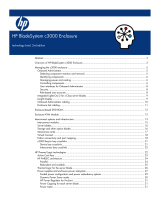
ISS Technology Update Volume 7, Number 8
4
Meet the Expert — Kim Sides
Kim Sides has had a fruitful 20-year career with Industry Standard Servers (ISS).
She has achieved the level of ISS Master Technologist by demonstrating
dedication, innovation, and excellence in her work. As the speed and complexity
of designs have increased, Kim has been on the forefront of using new tools and
techniques to improve signal integrity (SI) analysis.
Name: Kim Sides
Title: Master Technologist - TGS ESS ISS
Shared Engineering Services
Years at HP: 20
University/Degree
• Louisiana State University: BSEE 1979
• University of Houston: MSEE 1987
U.S. Patents: 8
She is known as an unselfish team player whose soft-spoken and kind demeanor
are balanced by her intelligence and resolve. Her expertise is even sought out by
other HP engineers because of her willingness to help others to learn.
According to Ken Jansen, her manager, “Nothing ever seems to faze her. She just
looks at the job that needs to be done, determines the best way to do it, and gets
after it.” Ken said that in the almost 21 years that he has known Kim, he can
never remember seeing her get flustered. Kim achieves “balance” between body
and mind through her two hobbies: swimming and studying the Bible.
Kim and Jim, her husband, have been married for 21 years and have a son (20)
and a daughter (18). Below are excerpts from a conversation with Kim.
Why did you decide to become an engineer?
Kim: I was fascinated with a Basic Electrical Circuit course that I took in 8th
grade. During that class, I realized how mathematics can be used to solve real
physical problems, so I decided to be an electrical engineer.
What is your favorite invention or most interesting research?
Kim: My most interesting research was the Signal Integrity Etch Test Vehicle that I collaborated on with the Digital SI engineers
and Metrology lab in 2002. Up to that time, we never had a test vehicle that would enable us to extract loss tangent data as a
function of frequency. The Signal Integrity Etch Test Vehicle enabled us to extract the loss tangent of PCB material and correlate
between measurement and simulation for transmission line losses on printed wiring board copper traces. During this project, I
discovered the fiber weave effect in signal integrity of a differential pair of transmission line. The differential pairs on our test
vehicle were designed to have maximum of 0.18 picoseconds (ps) in-pair skew (difference in propagation delay between the
two traces), but in the lab we found there was up to 59 ps in-pair skew in some differential pairs. This large skew significantly
reduced signal quality of the differential transmission lines. Using simulation and measurement data, we proved that the
unexpected skew was due to non-homogenous PCB dielectric material. PCB dielectric material is a mixture of resin and
fiberglass weave fabric. Fiberglass has much higher dielectric constant than resin, so if one trace is routed over the fiber weave
and the other trace is not, then there will be a difference in velocity between the two traces. Today, we route all differential
high-speed signals at an angle to mitigate the in-pair skew due to the fiber weave effect.
How much customer input goes into the design of your products?
Kim: I don’t have direct contact with customers, so I get customer input by working with the product groups. Customers want
reliable, innovative, and cost-effective products. I take these criteria seriously in my signal integrity work.
What must HP do to remain the leader in industry-standard servers?
Kim: I believe that HP should continue to increase investment in research and development in the areas of signal integrity and
power integrity. In order to produce servers that operate reliably at multi-gigahertz speed, we must expand our knowledge and
experience in these areas. This requires us to accurately model and simulate high-speed channels and power distribution
networks.








